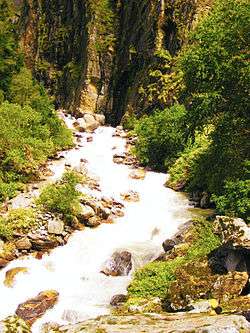Pushpawati River
Pushpawati River flows through the Valley of Flowers in Chamoli district in Garhwal region of the Indian state of Uttarakhand.
| Pushpawati River | |
|---|---|
 The Pushpawati rushing out of Valley of Flowers | |
| Location | |
| Country | India |
| Basin features | |
| River system | Alaknanda River |
Course
The Pushpawati rises from the East Kamet Glacier, near Rataban, at the base of the Himalayas near the central part of the Garhwal-Tibet border. It flows in a southerly direction to join the Bhyundar Ganga near Ghagharia. The combined stream is thereafter known as the Lakshman Ganga. The latter merges with the Alaknanda River at Govindghat.[1][2]
The Puspawati drains the Valley of Flowers.[1]
The glaciated upper valley of the Pushawati is U-shaped. The river flows past thick glacial deposits. A number of glacier-fed streams join it in its upper reaches. It flows through a gorge in its lower reaches. The upper tracts are under permanent cover of snow. Alpine, sub-alpine and temperate vegetation is there in the middle and lower catchments of the river. Human habitation is very sparse.[1]
Mythology
According to legend, the Pandavas, during their years of exile, saw flowers floating down the river. They named it Pushpawati.[1]
Gallery
 A view of Pushpawati from the gorge crossing while entering the Valley of Flowers
A view of Pushpawati from the gorge crossing while entering the Valley of Flowers A bridge over Pushpawati River, while entering into the Valley of Flowers
A bridge over Pushpawati River, while entering into the Valley of Flowers
See also
- Valley of Flowers
- Gobindghat
References
- Negi, Sharad Singh. Himalayan rivers, glaciers and lakes. p. 111. Google books. Retrieved 1 June 2010.
- De Sarkar, Partha. Valley of Flowers and Hemkund Sahib. Retrieved 1 June 2010.
| Wikimedia Commons has media related to Pushpawati. |